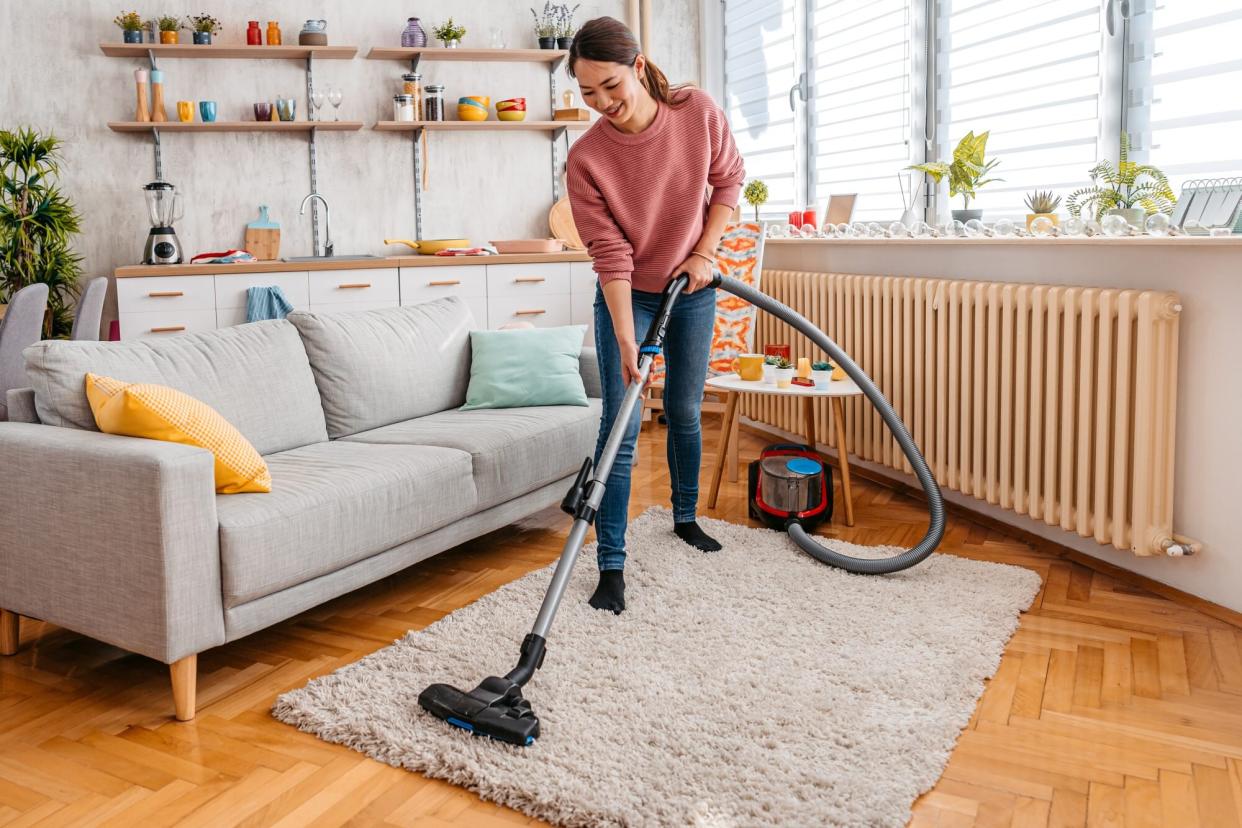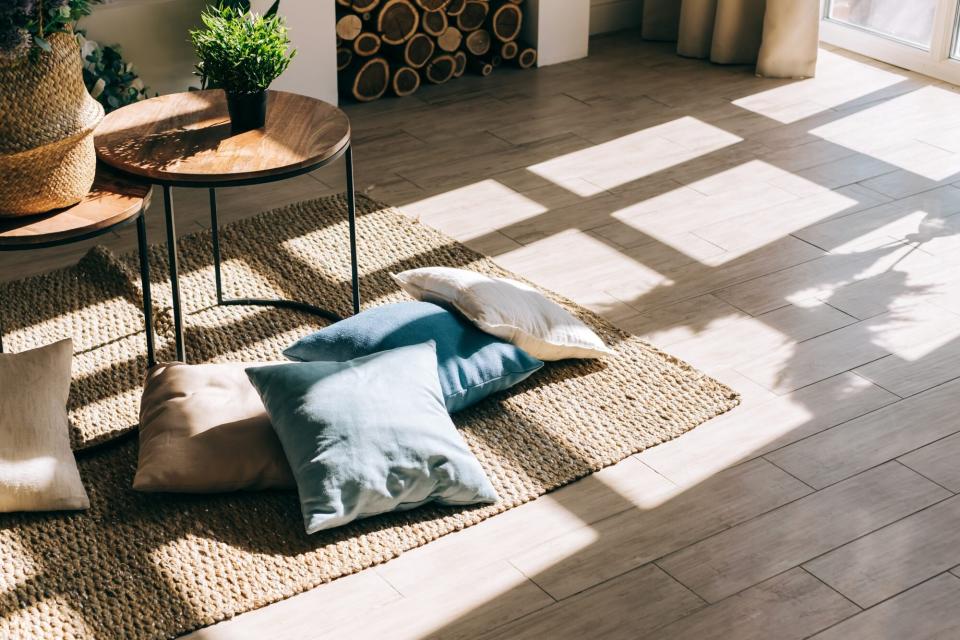How to Clean Every Type of Rug the Right Way

GETTY IMAGES
TABLE OF CONTENTS
On This Page
Why It's Important to Clean Your Rugs
What You'll Need
Wool
Cotton
Silk
Polyester
Jute
Washable
Vintage
Professional Cleaning
When you begin cleaning, you probably start by tackling the areas of your home that see the most action, like your bathroom sink or kitchen countertops. But the most highly-trafficked spot in your house is right under your nose—actually, it's right below your feet. Your rugs gather dirt and debris with every step you take, and require routine care to keep them clean. But how you clean your rug depends on its material, which prompt all kinds of questions about the right methods and ingredients to use.
To help, we tapped several experts who shared how to properly clean every type of rug in your home, from cotton and wool to silk and polyester and everything in between.
Related: The 8 Best Vintage-Style Rugs to Bring a Classic, Old-World Feel to Every Part of Your Home
Why It's Important to Clean Your Rugs
It's easy to forget about cleaning your rugs, but these pieces require a routine refresh like any other part of your home, says Mary St. John, a marketing specialist at Rugs.com. "To keep your carpet looking soft, plush, and clean, we recommend regular vacuuming at least once a week, especially in high-traffic areas," she says. "Maintaining a rug cleaning schedule will help keep dirt and odors away and [prevent] your rug from showing wear and tear."
Deep Cleaning
When it comes to deep cleaning a rug, opt for a professional treatment at least every three to five years. This will keep rugs in mint condition, says Ben Hyman, the CEO and co-founder of Revival.
What You'll Need
To clean most rug types, you'll need a vacuum (non-rotatory options are preferred to limit carpet damage) to remove debris, white cotton towels to absorb liquid spills, and baking soda to prevent stains from setting, says Mary Gagliardi, Clorox's in-house scientist and cleaning expert. Have paper towels, mild detergents (like watered-down dish soap), and clean water on hand, too.
Spot-Treating Rugs
Most rug types cannot be tossed into the washing machine after a particularly bad spill, so make sure you have what you need to effectively spot-treat. "When spot-treating, technique matters," Gagliardi says. When a spill happens, act quickly; press your cotton towels into the mess to quickly absorb the liquid and prevent the stain from setting.
When battling oil spills, use baking soda. After applying it over the spot, allow the cleaning agent to absorb the spill and dry before vacuuming it up.
How to Clean Wool Rugs
A wool rug is natural and durable, so it can handle routine vacuuming; it doesn't require extensive, specialized cleaning, says St. John. "Natural materials can hold dirt in the small fibers, so vacuum regularly," she adds. "If you still find dirt stuck in your rug after vacuuming, give it a good, old-fashioned shake outside."
How to Remove Stains
The natural oils in a wool rug, called lanolin, are its first line of defense and prevents stains from setting into the fibers, says Hyman. Before you treat any stains, however, it's important to identify whether you have a hand-knotted or flatweave wool rug—and then clean accordingly.
Hand-Knotted Rugs
Hand-knotted rugs typically have a pile, so they are thicker; all are completely handmade.
If the spill is organic and non-oily (like wine), use a paper towel or cloth to blot the liquid.
Add clean water gradually to the spot to dilute the stain (or wet a paper towel or cloth) and blot.
Repeat these steps until the stain is removed.
For persistent stains, apply a mild detergent, like diluted dish soap, and continue blotting with the aforementioned steps.
If the spill is a denser, more oily liquid, Hyman recommends trying to scoop up the mess from the surface of the rug with a spoon; then, complete the same blot-and-rinse technique above. If the spill is non-organic, and composed of chemical substances—or the above methods don't work—he suggests having a professional hand-wash the rug as soon as possible.
Flatweave Rugs
Flatweave wool rugs do not have a pile and are relatively "flat" to the ground. Moisture can get trapped in rugs with horizontal fibers, which flatweaves have, so simply blot the spill until it is dry—don't apply cleaning mixtures. "Adding liquid can make it harder to remove stains, and can even extend them further," says Hyman. If the stain persists, consult a specialist as soon as possible, he advises.

Thomas Richter of The White Arrow
How to Clean Cotton Rugs
Vacuum cotton rugs regularly (at least once a week) to prevent dust and crumbs from settling into the roots of the fibers, notes Hyman. Avoid direct and continuous exposure to sunlight to prevent discoloration.
Rugs made from cotton can typically be machine-washed, adds Gagliardi. "Laundry detergent and the appropriate laundry bleach additives can be used as long as the material is colorfast," she says. "Follow the instructions on the rug's care label and use the warmest water possible for better cleaning." Air-dry completely before placing them back on your flooring.
How to Remove Stains
Blot with a clean, undyed cotton cloth.
Apply a mild soap and water solution and press to absorb as much of the mark as possible, says Hyman.
How to Clean Silk Rugs
Shake gently to remove debris, and clean regularly using a non-rotary vacuum, says Hyman. Rotate on occasion to ensure even wear over time. Prevent moisture build-up by making sure your rug is completely dry after spot-treating—hanging it in the sun for a few hours can help.
How to Remove Stains
Gently blot the affected area with a damp cloth using a gentle soap and water. Don't scrub—this could cause the stain to spread.
If stain persists, bring your rug to a professional, says Hyman.
How to Clean Polyester or Polypropylene Rugs
These rugs are stain-resistant, durable, and typically suited for indoor and outdoor use, which makes them a great choice for high-traffic areas, says St. John. "The flatweave construction and tough materials mean polyester or polypropylene are also easy to clean," she says. Regular vacuuming is required to pick up excess dirt.
How to Remove Stains
Since these rugs are durable, they can be tossed in the washing machine to remove excess dirt and stains, note our experts. Regular laundry detergents and laundry additives, such as Clorox Disinfecting Bleach, can be used together to machine-wash a synthetic area rug if it is colorfast, explains Gagliardi.

nikkimeel / Getty Images
How to Clean Jute Rugs
Remove excess dirt from this rug type with a non-rotary, low-powered vacuum. Don't use a beater bar (the vacuum's rotating brush is too rough). Instead, shake the rug if necessary and rotate on occasion to ensure even wear over time; keep it away from high-moisture areas of your home.
How to Remove Stains
Gently blot the affected area with a damp cloth using a gentle soap and water; scrubbing could cause the stain to spread, says Hyman.
If stain persists, take your rug to a professional for cleaning.
How to Clean Washable Rugs
Place washable rugs in areas of your home with the highest foot traffic, like entryways or kitchens, St. John advises. A rug that is marketed as washable might be made of a mix of materials, but its cleaning method is straightforward: Aside from vacuuming, follow the label instructions and toss it right into your washing machine.
How to Remove Stains
You don't need to put your washable rug in the washing machine if you're managing a small spill, St. John says. Use basic spot-cleaning tactics for small messes made in between washes: Using a damp cotton towel dipped in mild soap and water, apply pressure to blot the affected area.
For large messes or washable rugs that need a more thorough cleanse, follow these steps:
Put your rug in the washer with the color and pattern facing down.
Use a clear detergent with no bleach, and set your washer to a delicate and light cycle using cold water.
Allow your rug to air-dry. Note: Don't put your washable rug in the dryer, since high temperatures can damage synthetic materials, explains St. John.

Laure Joliet
How to Clean Vintage Rugs
Since dust can erode vintage rugs' delicate fibers over time, they should be vacuumed once or twice per month; use a small attachment to prevent rolling heavy machinery over these pieces. If your rug is small, bring it outside and give it a good shake once a week.
"Once a year, let it sunbathe," adds Hyman. "Hang it in the sun for a few hours when it's hottest, and flip it over midway through, to expose both sides to direct sunlight. This sun-bleaching helps further sanitize the wool. It's a natural method to bleach and deodorize."
How to Remove Stains
Use an undyed cloth to blot the stain with mild soap and water, says Hyman. Don't rub or use harsh chemicals on the piece, as it could damage the fibers. If your heirloom is particularly delicate, get the piece cleaned professionally as a cautionary measure.
Rugs That Always Require Professional Care
While you can care for most rugs at home with weekly vacuuming and spot-treating, there are a couple types that should only receive professional treatments, explain our experts. "Persian rugs should always be professionally cleaned," says St. John. "These rugs have vegetable dyes for the colors, and if they are exposed to water or chemicals, they can be damaged." And if you have a vintage rug that is near or over 100 years old, it will need professional care to ensure it lasts, she adds.

